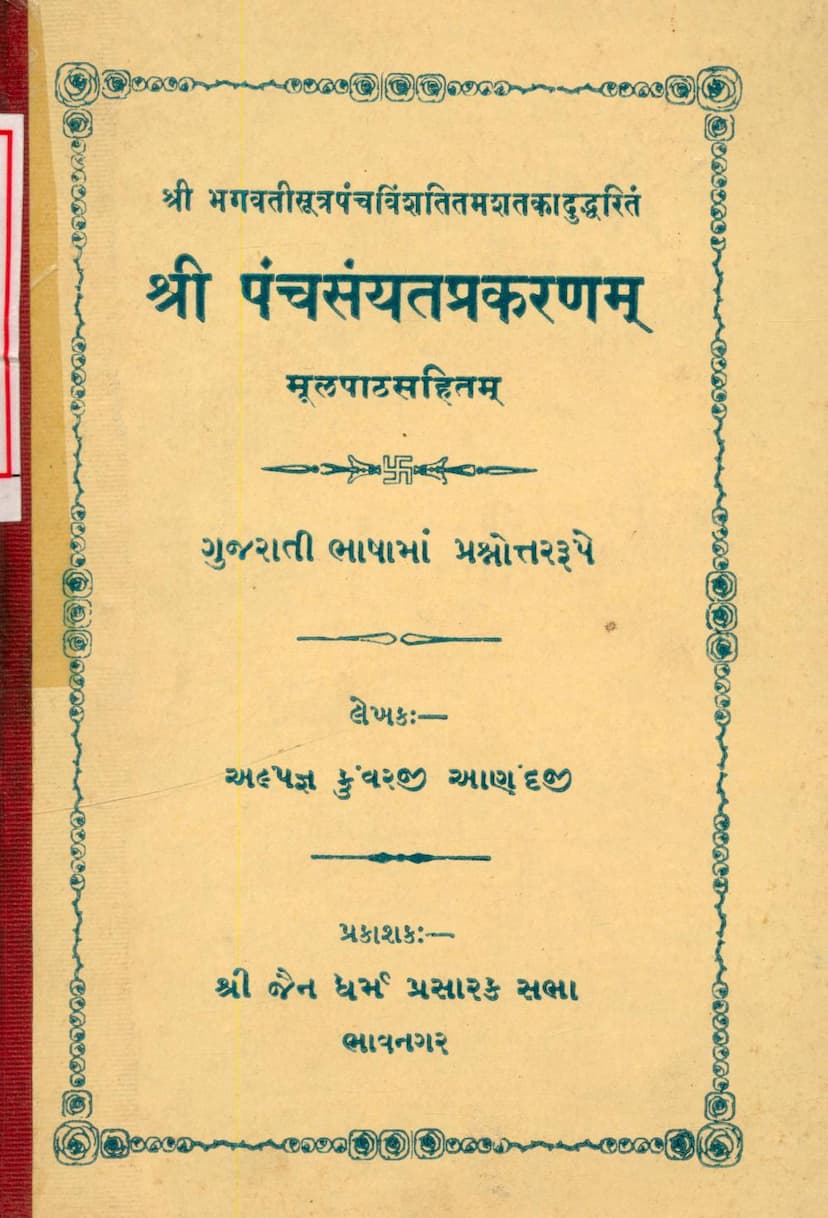Panch Sanyat Prakaranam
Added to library: September 2, 2025

Summary
Here's a comprehensive summary of the Jain text "Panch Sanyat Prakaranam" by Kunvarji Anandji, based on the provided text:
Book Title: Panch Sanyat Prakaranam (The Chapter on the Five Types of Restraint/Conduct)
Author: Kunvarji Anandji (described as "Alpamatim" - of limited intellect, indicating humility)
Publisher: Shri Jain Dharma Prasarak Sabha, Bhavnagar
Source: Extracted from the 25th Shatak (century), 7th Uddesha (section) of the revered Jain scripture, Shri Bhagavati Sutra.
Core Purpose and Content:
This book is a detailed exposition of the "Panch Sanyat" (five types of restraint or righteous conduct) as described in the Bhagavati Sutra. The author, Kunvarji Anandji, has presented this complex topic in a question-and-answer format in Gujarati, making it accessible to a wider audience. The work aims to provide a comprehensive understanding of these five types of conduct by systematically detailing 36 "Dwar" (doors or aspects) for each.
The author notes that while the Bhagavati Sutra itself details "Panch Nigranth" (five types of ascetics) with 36 Dwar, the section on "Panch Sanyat" is more concise and often refers back to the "Panch Nigranth" section for elaboration. To make the "Panch Sanyat" section self-contained and understandable, Kunvarji Anandji has expanded on these references, effectively creating a complete explanation for the five types of restraint.
The Five Types of Sanyat (Restraint/Conduct):
The book systematically describes the following five types of Sanyat:
- Samayik Sanyat: Associated with the practice of samayik (equanimity, meditation).
- Chhedopasthapaniya Sanyat: A type of conduct involving the re-establishment of great vows after some transgression or change in lineage.
- Pariharavishuddhika Sanyat: A higher form of conduct involving specific purification practices.
- Sukshmaparay Sanyat: The stage of extremely subtle passions.
- Yathakhyat Sanyat: The perfectly pure and true conduct, achieved by the omniscient ones.
Key Aspects (36 Dwar) Covered for Each Sanyat:
The book elaborates on 36 specific aspects (Dwar) for each of the five Sanyat. These include:
- Prajnapan (Classification): Defining the types within each Sanyat (e.g., Samayik Sanyat is of two types: Itariy and Yavata-kathik).
- Ved (Sense/Feeling): Whether they experience pleasure/pain.
- Rag (Attachment/Passion): Whether they are with or without passion.
- Kalp (Type of Conduct/Discipline): Whether they adhere to the Jin-Kalpa, Sthavir-Kalpa, or are Kalpatiit (beyond Kalpas).
- Charitra (Conduct): How their conduct relates to the stages like Pulaka, Kushil, etc.
- Pratisewana (Violation): Whether they violate their vows (Pratisewak) or not (Apratisewak).
- Gyan (Knowledge): The types of knowledge they possess.
- Shrut (Scriptural Knowledge): The extent of their scriptural learning.
- Tirth (Spiritual Order/Dispensation): Whether they exist within a Tirth (ordained order) or outside of it.
- Ling (Attire/Appearance): Their outward appearance or clothing.
- Sharir (Body): The types of bodies they possess.
- Kshetra (Region): The geographical regions they inhabit (Karmabhumi, Akarmabhumi).
- Kal (Time): The eras (Utsarpini, Avasarpini) and specific periods they exist in.
- Gati (Destination/Rebirth): The realms they attain after death.
- Sanyam (Restraint): The stages of restraint and their relative quantity (Alpamatva).
- Sannikash (Proximity/Period): The duration of their practice.
- Yog (Activity): Their involvement of mind, speech, and body.
- Upayog (Consciousness/Focus): Whether they are Sakar (with form) or Akar (formless) in their focus.
- Kashay (Passions): The types and intensity of passions they experience.
- Leshyā (Subtle Predisposition/Aura): Their aura or inclination (Prakriti of Leshyā).
- Parinam (Disposition/Tendency): Their mental disposition (growing, declining, or stable).
- Bandh (Bondage): The types and number of karmas they bind.
- Vedan (Experiencing): The karmas they experience or undergo.
- Udīrana (Eruption of Karma): The karmas that erupt before their due time.
- Upasampada-Hāni (Acquiring and Abandoning): What they give up and what they attain when transitioning between states.
- Sanjna (Consciousness/Perception): Whether they are attached to worldly matters or detached.
- Ahar (Food/Sustenance): Whether they take sustenance or are without it.
- Bhav (Lifespan/Existences): The number of lifetimes they may take.
- Akarsh (Attractions/Acquisitions): The number of times they can attain a particular state within a life or across lifetimes.
- Kalman (Time Measurement): Detailed timings and durations.
- Antar (Interval): The gaps between attaining a particular state.
- Samudghat (Emanation/Projection): Whether they can project their consciousness or essence.
- Kshetra (Scope/Reach): The extent of their presence in the universe.
- Sparshana (Touch/Contact): The extent of their contact or influence.
- Bhava (State of Being): The ultimate spiritual state they achieve.
- Pariman (Quantity/Number): The number of individuals in each category.
- Alpamatva (Less-More Comparison): Comparative analysis of the quantities of each Sanyat.
Author's Approach and Contribution:
- Q&A Format: The book's question-and-answer structure, based on the Bhagavati Sutra, makes intricate philosophical points easier to grasp.
- Gujarati Translation and Explanation: It provides a Gujarati rendering and commentary, making the original Sanskrit/Prakrit text accessible.
- Self-Contained Explanation: By elaborating on references to "Panch Nigranth," the author ensures the reader doesn't need to consult other texts for basic understanding.
- Humility and Appeal for Correction: The author expresses humility about his limited intellect and earnestly requests scholars and monastics to point out any errors for improvement.
- Detailed Explanations: The text includes detailed explanations, often referencing commentaries (Tika) and clarifying subtle points about stages of conduct, karma, and spiritual progression.
Significance:
"Panch Sanyat Prakaranam" serves as a vital resource for understanding the subtle distinctions and progressive stages of spiritual practice within Jainism, as outlined in the Bhagavati Sutra. It highlights the meticulous classification and analysis of spiritual states and activities that are central to Jain philosophy. The work is dedicated to students and practitioners of these stages, offering a clear and structured path to comprehending these fundamental principles.